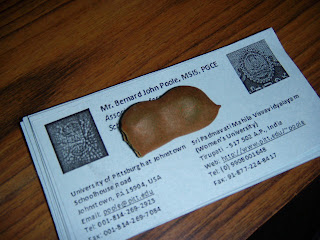



This morning (Dec. 18) I was walking towards one of the buildings on the campus of the university and noticed some students reaching up and pulling something off a tree. I wondered if it might be one of those trees the twigs of which people in Africa and China, and maybe India, too, use to clean their teeth. But it turns out this was a tamarind tree and the girls were plucking the fruit.
When I asked what they were doing, I was offered some of the fruit. I took it (it looked like a pea pod) and I held it in my hand, wondering what I was supposed to do with it. I asked, and the girl bit into it and invited me to do the same, which I did. It had a sweetly bitter taste and was deliciously refreshing. Later, I looked up tamarind in the dictionary and learned that it’s a fruit used to flavor drinks, apart from other things.
Talking about drinks, I haven’t touched one—alcoholic, that is—since I arrived in India. According to what I have read prior to coming here, public consumption of alcohol is frowned on most everywhere. But when the Indian is at home, apparently anything goes. So I’m awaiting my first invitation to a soiree. Meanwhile, I have absolutely no idea where to buy alcohol other than in a hotel bar and, quite frankly, that’s just not my scene. But I wouldn’t mind a G&T right now. It’s nearly 5:00 in the evening; the sun’s soon to set over the yard arm; it’s about that time….
Six mornings a week, on my way to teach at 10:00 am in the School of Education, I take a shortcut through the bush. At a certain point along the way, I daily disturb a posey of pretty butterflies, which flutter up like a gossamer cloud from their butterfly garden and show off their finery—light blues and black and orange and white and cream. I hope they never go away, though I fear their life cycle may soon leave me bereft of their company.
On the other hand, like humans, one butterfly’s life cycle is independent of another’s, so there’s no reason why they should all disappear at once. The only reason that might happen would be if the butterflies lost their habitat. Sadly, the shortcut through the bush already threatens that as we humans, in our haste to get from place to place, heedlessly cut swaths through their territory. It’s not enough that we’ve carved asphalt roads through the bush to create the university campus; we have to carve out shortcuts, too?
In an earlier, pre-industrial age, Shakespeare’s Hamlet exclaims:
What a piece of work is a man! how noble in reason!
On the other hand, like humans, one butterfly’s life cycle is independent of another’s, so there’s no reason why they should all disappear at once. The only reason that might happen would be if the butterflies lost their habitat. Sadly, the shortcut through the bush already threatens that as we humans, in our haste to get from place to place, heedlessly cut swaths through their territory. It’s not enough that we’ve carved asphalt roads through the bush to create the university campus; we have to carve out shortcuts, too?
In an earlier, pre-industrial age, Shakespeare’s Hamlet exclaims:
What a piece of work is a man! how noble in reason!
how infinite in faculty! in form and moving
how express and admirable!
in action how like an angel!
in apprehension how like a god!
the beauty of the world! the paragon of animals!
I wonder if he would say the same today.
I wonder if he would say the same today.
I mentioned in an earlier blog that power cuts are not uncommon in this part of the world. We’ve had fewer than one a day since I arrived, and they’re always of short duration. But today was an exception. It seemed that the power was popping on and off all morning and all afternoon long. The first power cut this morning was particularly ill-timed. I was in a computer lab with 50 students. I’d given them each a CD-RW to use to store their files when they work their way through my tutorials. As Murphy’s Law would have it, half way through explaining to them how to save files on a CD, and about 15 minutes before the end of the session, we had a power cut.
It took a while for the implications to sink into my aging brain. We couldn’t continue with what we were doing; however, that’s OK since I can always come up with Plan B, even if it means yammering on about something vaguely intellectual for half an hour or so. But then one of the students pointed out that they couldn’t retrieve their CDs from the drives….
I never did like CDs for secondary storage; now I had another reason to hate the wretched things.
One of the students solved the problem by suggesting that each student write her name on her CD case and leave it on the table next to her computer. Then three of the students volunteered to stay behind till the power came back on, at which point they'd gather up all the CDs and return them to their fellow students later in the day. The power came back on a few minutes after the scheduled end of class, so their vigil was not prolonged.
This afternoon, after I finished guest lecturing to a group of Electronic Communications Engineers, I was invited over for a cup of tea in the Engineering office. The man who takes care of the building—a sort of general Engineering Department factotum—was sent off to get tea. While he was away, I was told that he had typhoid…
Yikes!! What on earth was he doing at work, let alone getting me tea, if he’s been diagnosed with typhoid? When he came back, I noticed for the first time that he did look a bit like death warmed up. I wasn’t concerned on my own behalf, mind, since I’ve recently been inoculated against typhoid, but what about everyone else in the office, in the building, in the university? Isn’t typhoid contagious?
I resolved to find out.
I did, and, well yes, typhoid is contagious, but not by contact with someone who has it. It’s a water-borne disease, so no worries.

No comments:
Post a Comment